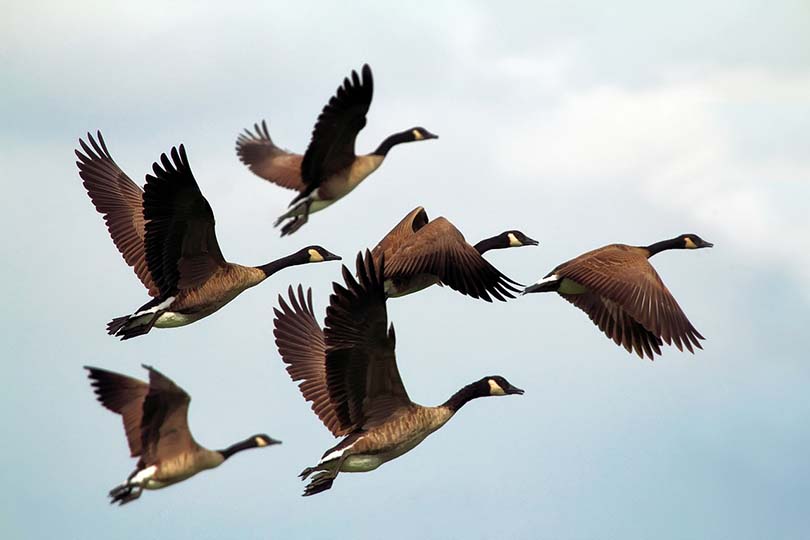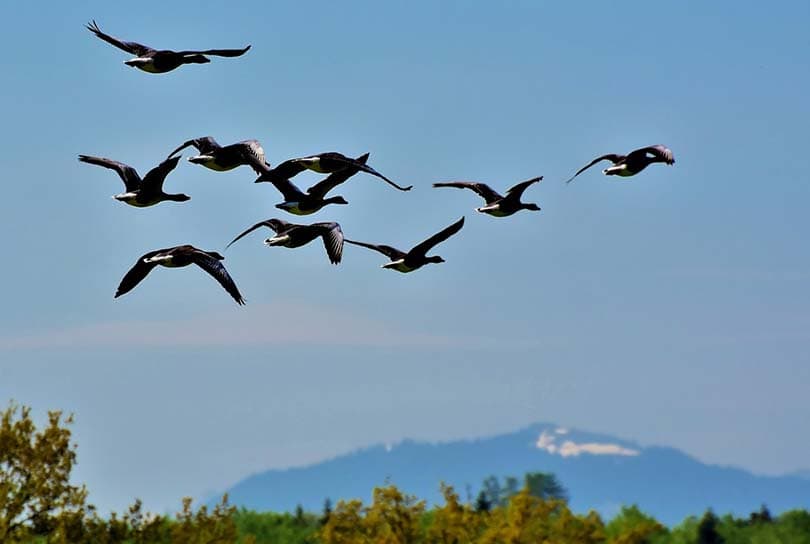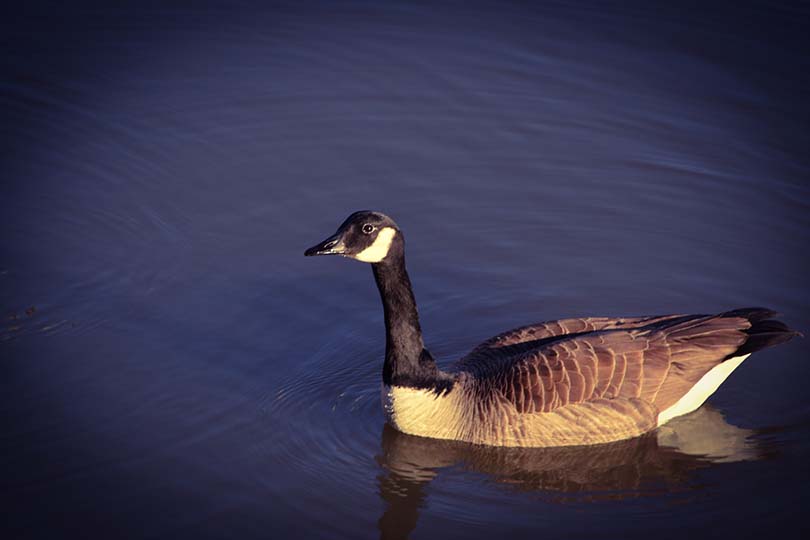Where Do Geese Migrate? How Do They Know Where to Go?
Last Updated on

If you’ve noticed a large population of geese in your area of the United States, they’re probably Canada geese that are the most widely known goose species in North America. Maybe you’ve seen large flocks migrating overhead during the fall months and wonder to yourself where do geese go in the winter.
Canada geese don’t always migrate during the fall or early winter but when they do, they head in a southerly direction toward warmer weather. Then once it’s spring and early summer again, they return to the area they migrated from to breed and have goslings. We’ll take a close look at the Canada goose species to enlighten you about these majestic birds that are widely found across the United States.

What a Canada Goose Looks Like and Where It Lives
The Canada goose is a large bird weighing between 5 and 14 pounds. It has a distinctive black head and neck with white cheeks. The body and wings are tannish brown. Regarding size, this bird is larger than a mallard duck and smaller than a mute swan.
Canada geese live and breed in the northern half of the United States in a wide range of habitats. There is a very large population of these geese living in the Great Lakes region and many living along the Pacific and Atlantic coasts.
These geese are found living near lakes, ponds, marshes, streams, wetlands, farms, public parks, and other urban areas. If you spend time outdoors basically anywhere in the northern half of the United States, you’ll likely see Canada geese or at least traces of them which may include feathers and droppings.

How Canada Geese Know When to Fly South
Canada geese and other migrating birds have internal clocks built into their brains that measure how much daylight there is each day. As the days become shorter when summer is fading away and early fall approaches, these birds instinctively know it’s time to get moving south. This is when you can see large flocks of Canada geese gathering in fields, gorging on grains and grasses to fatten up in preparation for their long flight south.
Where Geese Go When They Migrate
When geese in the United States fly south for the winter, they typically settle in the central portion of the country or the south. Since Canada geese are found throughout the United States, the only way to know where a specific goose family originates from is to look for baby geese or goslings as they’re called. If the geese in your area are breeding during the springtime, they likely live near you all year. If you see a family of geese in your area without any goslings, they’re likely migrating geese just passing through.

How They Know Where to Go
The interesting thing about migrating Canada geese is that they return to the same spot every year following their migration south. Nobody has a complete understanding of how migrating geese know where to go. However, it’s believed by many scientists that geese navigate their way home using the Earth’s magnetic field by evaluating its strength according to location as the magnetic field is stronger at the poles and weaker at the Equator.
Why Geese Fly in a V Formation
It’s always cool to see a flock of geese overhead, honking loudly while flying in a V formation. Birds like Canada geese fly this way because it reduces wind resistance, allowing them to expend less energy. By flying in a V formation, the geese can fly for longer distances before stopping to rest and eat. Each bird in the flock flies slightly above the bird in front of it to reduce wind resistance.
You can think of geese flying in a V formation much like you view cyclists riding behind one another in a race to save energy. The V formation also allows the birds to keep visual contact with one another so they can remain in formation and head in the right direction without crashing into each other or getting lost along the way.
If you’ve ever wondered how it’s determined which bird will be the leader in a V formation, you should know that they take turns being in the front. When the lead bird becomes tired, it falls back so another bird can take its place.

What Canada Geese Eat
Canada geese feast on a wide variety of plant materials including the bulbs, stems, and shoots of grasses and aquatic plants. These birds also eat seeds and berries and forage for grains found in open farmland and fields. Canada geese will also eat insects, mollusks, crustaceans, and even small fish.
These birds are herbivores that don’t really like feeding on fish but they’ll do so if it’s easy game. For instance, a Canada goose that’s submerging its head in a pond to eat aquatic plants will gladly chow down on small fish swimming about.
Tips for Feeding Wild Geese
If you’d like to feed wild geese, be aware of the fact that bread offers these birds very little nutritional value so skip it. A good item to feed geese in the wild is commercial goose food that contains things like corn, milo, and wheat.
When you feed geese, don’t do it by hand because you can be attacked. It’s best to make a pile of goose food on the ground and let the geese come to it. Just be cautious and let the geese be as they feast on the food you leave down for them.


In Conclusion
Now you don’t have to ask yourself where geese go in the winter because you know! The next time you see a V formation of Geese flying overhead during the late fall season, you’ll know those birds are heading to warmer weather. It’s perfectly fine to feed wild geese, just keep your distance because those beaks are sharp!
Featured Image Credit: 12019, Pixabay
About the Author Robert Sparks
Robert’s obsession with all things optical started early in life, when his optician father would bring home prototypes for Robert to play with. Nowadays, Robert is dedicated to helping others find the right optics for their needs. His hobbies include astronomy, astrophysics, and model building. Originally from Newark, NJ, he resides in Santa Fe, New Mexico, where the nighttime skies are filled with glittering stars.
Related Articles:
How to Clean a Refractor Telescope: Step-by-Step Guide
How to Clean a Telescope Eyepiece: Step-by-Step Guide
How to Clean a Rifle Scope: 8 Expert Tips
Monocular vs Telescope: Differences Explained (With Pictures)
What Is a Monocular Used For? 8 Common Functions
How to Clean a Telescope Mirror: 8 Expert Tips
Brightfield vs Phase Contrast Microscopy: The Differences Explained
SkyCamHD Drone Review: Pros, Cons, FAQ, & Verdict
